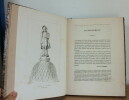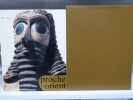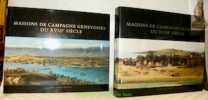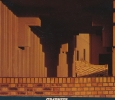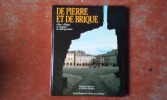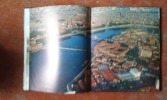-
Type
Any type (2)
Art print (7)
Book (30848)
Disk (1)
Drawings (7)
Engraving (9)
Magazine (129)
Old papers (1)
Photographs (14)
Posters (4)
-
Latest
Last 24h (4)
Last 3 days (7)
Last month (229)
Last week (129)
-
Language
Dutch (1)
English (54)
French (30921)
German (6)
Italian (18)
Japanese (2)
Portuguese (9)
Spanish (11)
-
Century
16th (16)
17th (56)
18th (209)
19th (1540)
20th (9203)
21st (1660)
-
Countries
Belgium (9485)
Brazil (7)
Canada (108)
China (3)
Côte d'Ivoire (67)
Denmark (218)
France (18069)
Germany (1)
Greece (1)
Italy (37)
Switzerland (3026)
-
Syndicate
ALAC (99)
CLAM (42)
CLAQ (94)
CNE (3)
ILAB (10650)
NVVA (1161)
SLACES (1161)
SLAM (8122)
SNCAO (9)
DANS L'OMBRE DES CATHEDRALES. Étude sur l'ésotérisme architectural et décoratif de Notre-Dame de Paris .
Adyar - G. & J. Niclaus Paris 1939 DANS L'OMBRE DES CATHEDRALES. Étude sur l'ésotérisme architectural et décoratif de Notre-Dame de Paris dans ses rapports avec le symbolisme hermétique, les doctrines secrètes, L'Astrologie, la Magie et l'Alchimie.In-8 ( 250 X 165 mm ) de 302 pages, broché sous couverture imprimée et jaquette. 6 planches photographiques en noir hors texte. EDITION ORIGINALE, exemplaire de remise en vente avec les papillons Niclaus. Jaquette et couverture tachées, bon exemplaire.
La colonne de la grande armée d'Austerlitz ou de la Victoire
La colonne de la grande armée d'Austerlitz ou de la Victoire de Ambroise Tardieu au Dépôt de l'atlas géographique Non Daté (1833). Le livre est illustré à la suite de 4 pages de texte, les 38 planches (COMPLET) représentent la vue générale, les médailles, piédestaux, bas-reliefs et la statue de l'Empereur au sommet de la colonne. Le livre mesure 32x25 cm et pèse 0,900 kg (c) Non paginé. Reliure d'époque cartonnée. Le livre est en état d’usage, bon, quelques rousseurs, coiffes frottée, absence de la page de titres.
Avertissement La Colonne de la Grande Armée, ce monument impérissable de la gloire des soldats français, était peu connue dans tous ses détails, son élévation empêchant l'oeil de distinguer jusqu'à son sommet les sculptures qui l'entourent. Les bas-reliefs, au nombre de quatre-vingts, représentent, dans une suite de belles compositions, tous les faits importants de l'étonnante campagne de 1805, depuis la levée du camp de Boulogne, jusqu'à la paix de Presbourg. J'ai pensé qu'il serait agréable aux nombreux admirateurs de notre gloire nationale, et aux braves qui l'ont élevée à un si haut degré, de posséder une description exacte du seul monument érigé à la Grande Armée par son illustre chef. En conséquence, j'ai dessiné et gravé avec le plus grand soin la vue générale, les piédestaux, bas-reliefs, statue et médailles dont il se compose, et n'ai rien négligé pour que l'exécution réponde à la noblesse du sujet, et que cet ouvrage forme, pour ainsi dire, le chapiteau du beau monument des Victoires et Conquêtes élevé par M. Panckoucke à la valeur française. Ambroise Tardieu
Gérard Ambroselli né en 1906, un artiste témoin de la Libération de l'Alsace : Exposition, Salle des Catherinettes, Colmar, 10-26 novembre 2000
De Bayser 2000 In-4 broché. Très bon état d’occasion.
Très bon état d’occasion
Hammacher - Silhouette De Seurat
, Kroller-Muller Museum, 1994 Hardcover, 83 pages, Texte en Francais / Tres belle exemplaire, ill. en couleur / n/b, 230 x 220 x 10 mm. ISBN 9789074453134.
Hammacher - Silhouette De Seurat
Bernard Palissy et ses continuateurs - A la recherche du paradis terrestre
Editions Flammarion, Paris, 1996. In-4, cartonnage éditeur sous jaquette illustrée en couleurs, 255 pp. Introduction - Chapitre I. Bernard Palissy (1510-1590) - II. Les Grottes - III. Les céramiques rustiques - IV. Bernard Palissy et "Saint-Porchaire" - VI. Les palissystes - Annexes - Notes - Bibliographie - Index.
Avec 203 illustrations et planches en noir et en couleurs. --- Plus d'informations sur le site archivesdunord.com
Phone number : 01 42 73 13 41
L'ART ANTIQUE DU PROCHE ORIENT.
Citadelles & Mazenod Paris 1977 Fort in-4 carré ( 320 X 255 mm ) de 601 pages, pleine toile sous jaquette illustrée en couleurs et étui maroquiné taupe. Superbe et abondante iconographie en couleurs et en noir dans et hors-texte. Très bel exemplaire en parfait état.
AMIET, Pierre, BARATTE, François, DESROCHES NOBLECOURT, Christiane, METZGER, Catherine, PASQUIER, Alain:
Reference : 87427aaf
Art in the Ancient World. A handbook of styles and forms.
London, Faber and Faber Limited, 1981, in-8vo, 567 p., fully illustr. with drawings in b/w, copy from the archives of the publisher with stamp ‘Exemplaire d’Archive’, orig. ill. clothbound.

(SLACES, NVVA)
Phone number : 41 (0)26 3223808
AMIET, Pierre, BARATTE, François, DESROCHES NOBLECOURT, Christiane, METZGER, Catherine, PASQUIER, Alain:
Reference : 87428aaf
Art in the Ancient World. A handbook of styles and forms.
London, Faber and Faber Limited, 1981, in-8vo, 567 p., fully illustr. with drawings in b/w, copy from the archives of the publisher with stamp ‘Exemplaire d’Archive’, orig. ill. clothbound with jacket.

(SLACES, NVVA)
Phone number : 41 (0)26 3223808
AMIET, Pierre, BARATTE, François, DESROCHES NOBLECOURT, Christiane, METZGER, Catherine, PASQUIER, Alain:
Reference : 87396aaf
Handbuch der Formen- und Stilkunde. Antike.
Fribourg, Office du Livre, 1981, in-8vo, 571 S., ill. mit 370 Abb., Verlags-Archiv Exemplar mit Stempel ‘Exemplaire d’Archive’, Original-Pappband. Schönes Exemplar.

(SLACES, NVVA)
Phone number : 41 (0)26 3223808
A.Milton Henry ; Lampugnani Vittorio
Reference : 113482
(1995)
ISBN : 2080117696 9782080117694
Architecture de la Renaissance Italienne. Brunelleschi à Michel Ange
Flammarion 1995 In-4 broché 29,7 cm sur 21. 399 pages. Couverture légèrement passée et écornée, premier plat légèrement plié, intérieur très propre. Bon état d’occasion.
Bon état d’occasion
IL ETAIT UNE FOIS L ' ABBAYE DE BEAUPORT . Contes , récits et traditions orales. Illustrés par A M Ollivier Henry .
Couverture rigide Liv éditions , 2010 , in4° cartonnage illustré éditeur , 93 pp . La somme de récits proposée dans ce recueil n'a pour but que de rassembler des écrits plus ou moins imaginaires et quelques témoignages oraux tournant autour de l'abbaye de Beauport. L'ensemble comporte trois grandes parties, toutes en rapport avec Beauport. La première concerne les moines, la seconde évoque quelques anecdotes liées à ce grand personnage que fut Saint Yves et la troisième rapporte quelques croyances populaires encore liées à la vie de l'abbaye.Cet ouvrage est d'une nature résolument originale. Aux récits récoltés par les cueilleurs de légendes, que sont Luzel, Sébillot ou encore Pierre Bernard, répond la technique de «mémoire de papier» de l'artiste A.-M. Ollivier-Henry. Alchimie subtile et improbable Langue: Français
Mobilit s du lignage anglo-normand de Briouze (mi-XIe si cle - 1326)
, Brepols, 2021 Hardback, 519 pages, Size:156 x 234 mm, Illustrations:18 b/w, 27 col., 9 tables b/w., 6 tables col., 15 maps b/w, 1 maps color, Language: French. ISBN 9782503592480.
Summary La famille de Briouze se d signe elle-m me, depuis le milieu du xie si cle, par un toponyme, en r f rence au centre originel de sa puissance territoriale. Le qualificatif d' anglo-normand employ pour d signer le lignage de Briouze permet d' voquer sa double appartenance culturelle. Le lignage d passe cette acception binaire en s'implantant dans les r gions annex es par la couronne anglaise. Les Briouze sont des seigneurs transr gionaux, puisqu'au gr des conqu tes, ils construisent un vaste patrimoine transmaritime, morcel l'int rieur du monde anglo-normand. Relier les parcours individuels et les strat gies lignag res aux volutions d'ensemble : cette d marche permet de saisir la compl mentarit des ph nom nes des chelles vari es pour discerner les particularismes propres aux Briouze. L'interconnexion entre expansion territoriale, ascension sociale et loyaut envers la royaut est l'une des caract ristiques de leur histoire. Cette derni re est crite par le recoupement d'actes collect s dans les fonds eccl siastiques et les archives du pouvoir souverain, crois s aux discours produits par l'historiographie m di vale. Les discontinuit s co ncident avec l' volution de la structure du lignage et des rapports entre la famille et le pouvoir. La capacit d'adaptation - ou l'inadaptation - du lignage de Briouze aux diff rentes formes de mobilit s, question centrale de cet ouvrage, transpara t dans leur aptitude affronter et surmonter les situations de crise. l'intersection des formes de mobilit s aux volutions distinctes - politique, sociale, culturelle et conomique - se trouve la mobilit g ographique, trait d'union entre ces transformations diff renci es ainsi imbriqu es. Chaque rupture, chaque chute du lignage clate sous la pression du pouvoir politique mais survient lorsque les possibilit s d'expansions territoriales sont contrari es ou emp ch es. TABLE OF CONTENTS Remerciements Abr viations Pr face Remerciements Table des mati res Abr viations Pr face Introduction. Sur les traces des Briouze Premi re partie : 1066-1175 Des seigneurs pionniers Briouze, du toponyme la topolign e La seigneurie nouvelle de Briouze aux confins du duch Guillaume Ier de Briouze (c. 1030-c. 1095), de Briouze Bramber, gardien des fronti res du monde anglo-normand La fid lit des Briouze face l'instabilit du pouvoir (1087-1154) Conclusion : Distance entre les Briouze et le pouvoir royal Tripolarit castrale Briouze, en bordure du marais du Grand Haz Bramber, dans l'estuaire de l'Adur Radnor, sur un peron rocheux de la Radnor Forest Conclusion : la conqu te de l'ouest Fondations b n dictines Le fief de Briouze, entre id al aristocratique et r alit monastique La seigneurie de Bramber, un nouvel enjeu tr s attractif Conclusion : D centrement du dominium Polarisation des affinit s Une topolign e mobile au gr des strat gies matrimoniales La parent de Briouze, un r seau gocentr Identifier les r seaux de fid lit dans l'entourage seigneurial Conclusion : Typologie de la polarisation des affinit s G rer la dispersion des richesses fonci res Le capital : les terres recens es par les enqu tes royales Les ressources : profits compl mentaires issus du domaine Le personnel : d l gation de la gestion des terres parses Les charges : indices d'une strat gie d'extension territoriale Conclusion : G rer le polycentrisme territorial Deuxi me partie : 1175-1211 De pionnier occupant, expansion castrale dans la marche de Galles Densification de l'implantation galloise Les Briouze, gardiens et protecteurs de ch teaux de la marche Conclusion : tre seigneur dans une r gion frontali re hybride Portrait historiographique de Guillaume III, seigneur de la marche Un guerrier cruel Un chevalier pieux, protecteur de l' glise galloise Conclusion : Portrait ambivalent d'un seigneur de la marche Guillaume III de Briouze, favori du roi Jean (1199-1207) Les tapes de la faveur royale Guillaume III a-t-il les moyens de ses ambitions ? Conclusion : Les pr mices de la disgr ce Pr valence de la parent le dans l'entourage de Guillaume III de Briouze Importance des Saint-Val ry Placer ses parents Conclusion : Un r seau familial en clair-obscur L'obsession irlandaise La m moire d'un chec familial (1177) Guillaume III de Briouze obnubil par Limerick Les absents ont toujours tort Conclusion : Risquer les p rils de la Fortune La Fortune destructrice : r cits d'un d clin Les motifs narratifs de la chute Les r cits de la chute, critiques voil es du pouvoir royal Mathilde de Briouze, cible de la disgr ce Guillaume IV le Jeune, l'oubli des r cits Dualit des contestations de Gilles de Briouze, v que rebelle Conclusion : Une v rit insaisissable Troisi me partie : 1211-1326 Alt rit s (1211-1232) Quand le parent devient Autre Alt ration de l'autorit familiale divis e Quand l'Autre devient parent Conclusion : Un patronyme, deux sous-lign es ve de Briouze et ses filles (1230-1246) ve, pouse de Guillaume V de Briouze et dame de la Marche Les quatre filles d' ve, objets de convoitise ve, une jeune veuve dynamique et autonome Conclusion : Extinction de la sous-lign e cadette Chevaliers au lion (mi-XIIIe si cle-1326) La figure du chef : expression de la domination seigneuriale Guillaume VI, un loyal partisan du roi Le lion combattant pour la lutte du Bien contre le Mal Embl me du chevalier chr tien Conclusion : Identit et m moire familiale L'attachement des vassaux Implantation des lign es vassaliques Servir les seigneurs de Briouze Conclusion : Des liens d'affection durables Dislocation de la puissance seigneuriale Jean de Montbray, le substitut Le Gower et la remise en cause de l'autorit des Briouze La r action des Briouze Conclusion : Collision de trajectoires Conclusion : Progressions du lignage de Briouze Annexe 1: Actes mis par les seigneurs de Briouze Annexe 2: Les possessions anglaises de Guillaume Ier de Briouze selon le Domesday Book Annexe 3: Itin raire de Guillaume III de Briouze, t moin royal (1194-1207) Annexe 4: Enqu te men e en 1319 sur les terres de Guillaume VII de Briouze, seigneur de Gower Sources et Bibliographie Table des figures
Drawings of Peter Paul Rubens, A Critical Catalogue, Volume One (1590-1608) 2 VOLS.
, Brepols 2021, 2021 2 vols., 536 pages ., 216 x 280 mm , 260 colour ill., English, Hardcover, . FINE ISBN 9782503595702.
This is Volume I of the three-volume catalogue raisonn of all drawings considered by the authors to be by Rubens. It covers the years 1590- 1608, Volumes II and III dealing, respectively, with the periods 1609?20 and 1621?40. It is the first publication that presents the artist?s entire drawn oeuvre in chronological order, previous such publications containing only selections of drawings. By leafing through the illustrations, this arrangement provides the user with a quick visual impression of the variety of techniques, media, subject and functions of Rubens?s drawings at an one time. Volume I consists of the drawings of the artist?s childhood, apprenticeship and first years as a master in Antwerp to his formative years in Italy, spent mostly in Mantua and Rome, with an excursion to Spain. These are the years primarily devoted to learning and absorbing the art of the past, from sixteenth-century German and Netherlandish prints to the works of the ancient and Italian Renaissance masters. A large number of these drawings consists of copies after the works of other artists, largely executed as part of the artistic training at the time. For the first time, Rubens?s copies and their models are not discussed and illustrated as a separate entity but are fully integrated into the rest of his graphic oeuvre, thus showing copies and original compositions created at the same time side by side. The volume contains 204 entries, including several sheets with drawings on recto and verso. Each entry consists of a detailed physical description of the drawing, provenance, exhibition history, full bibliography and a critical, interpretive discussion. In addition, Volume I contains an essay on the history of the scholarship of Rubens?s drawings, a subject that has not been treated before. All drawings by Rubens and the works by other artists he copied as well as a selection of other comparative images are reproduced in color. Anne-Marie Logan is a specialist in Rubens?s drawings and in those of his Flemish contemporaries, especially Van Dyck's. Kristin Lohse Belkin is a Rubens specialist who has carried out extensive research on the artist.
Drawings of Peter Paul Rubens, A Critical Catalogue vols; 1-6, - 6-volumes catalogue raisonn of all drawings. * The Drawings of Peter Paul Rubens, A Critical Catalogue, Volume One (1590?1608) 2 vols. * The Drawings of Peter Paul Rubens, A Critical Catalogue, Volume Two (1609?1620) 2 vols. * The Drawings of Peter Paul Rubens, A Critical Catalogue, Volume Three, 1621?1640) 2 vols Part One: Text and Part Two: Plates
, Brepols - Harvey Miller, 2021-2023-2025 6 vols., 536 pages + 732 + 555 pages, 216 x 280 mm , 260 + 291 colour ill., English, Hardcovers, **NEW. ISBN 9782503595702.
This is the 6 -volume catalogue raisonn of all drawings considered by the authors to be by Rubens. It covers the years 1590- 1608, Volumes II and III dealing, respectively, with the periods 1609-20 and 1621- 40 and * The Drawings of Peter Paul Rubens, A Critical Catalogue, Volume One (1590?1608) * The Drawings of Peter Paul Rubens, A Critical Catalogue, Volume Two (1609?1620) * The Drawings of Peter Paul Rubens, A Critical Catalogue, Volume Three, 1621?1640 It is the first publication that presents the artist?s entire drawn oeuvre in chronological order, previous such publications containing only selections of drawings. By leafing through the illustrations, this arrangement provides the user with a quick visual impression of the variety of techniques, media, subject and functions of Rubens?s drawings at an one time. Volume I consists of the drawings of the artist?s childhood, apprenticeship and first years as a master in Antwerp to his formative years in Italy, spent mostly in Mantua and Rome, with an excursion to Spain. These are the years primarily devoted to learning and absorbing the art of the past, from sixteenth-century German and Netherlandish prints to the works of the ancient and Italian Renaissance masters. A large number of these drawings consists of copies after the works of other artists, largely executed as part of the artistic training at the time. For the first time, Rubens's copies and their models are not discussed and illustrated as a separate entity but are fully integrated into the rest of his graphic oeuvre, thus showing copies and original compositions created at the same time side by side. The volume contains 204 entries, including several sheets with drawings on recto and verso. Each entry consists of a detailed physical description of the drawing, provenance, exhibition history, full bibliography and a critical, interpretive discussion. In addition, Volume I contains an essay on the history of the scholarship of Rubens?s drawings, a subject that has not been treated before. All drawings by Rubens and the works by other artists he copied as well as a selection of other comparative images are reproduced in color. This is Volume II in the three-volume catalogue raisonn of the drawings by Rubens covering the years 1609?20. The project is a collaboration between Anne-Marie Logan, to whom belong all the Rubens attributions, and Kristin Lohse Belkin. It is the first publication that presents the artist?s entire drawn oeuvre in chronological order, previous such publications containing only selections of drawings. By leafing through the illustrations, this arrangement offers the user a quick visual impression of the variety of techniques, media, subject matter and functions of Rubens?s drawings at any one time. Accordingly, Volume II consists of the drawings from the time of Rubens?s return from Italy and the establishment of his workshop in Antwerp to the completion of his contribution to the furnishing and decoration of the city?s new Jesuit church, today?s St. Charles Borromeo. The decade is characterized by a broad range of genres and iconography: large altarpieces stand next to cabinet-size pictures, book illustrations next to designs for tapestry, sculpture and architectural reliefs; religious, mythological and historical subjects alternate with allegories, portraits, exotic hunts and scenes from country life. Copies after other artists? works that constitute such a large part of Rubens's early years discussed in Volume I have given way to original inventions in pen and ink and, above all, by life studies in chalk of the human body, naked or dressed. The whole spectrum of Rubens's extraordinary creativity, nowhere presented as directly and immediately as in his drawings, is there to be contemplated in all its astonishing diversity. Each entry consists of a detailed physical description of the drawing, provenance, exhibition history, full bibliography and a critical, interpretive discussion. All drawings by Rubens as well as a selection of comparative images are reproduced in color.
Maisons de campage genevoises du XVIIIe siècle. Avant-propos de Pierre Keller et Thierry Lombard. Préface d’Olivier Fatio. Tome I et tome II.
Genève, Domus Antiqua Helvetica 1999- 2001, 250x310mm, 348 + 319pages, reliure d'éditeur sous jaquette. Format oblong, “à l’italienne”. Très bel exemplaire, comme neuf.
photos couleurs et n/b, avec le plan dépliant et le tiré à part “Landey”, Pour un paiement via PayPal, veuillez nous en faire la demande et nous vous enverrons une facture PayPal
Vieilles Maisons Françaises n° 52 . Avril 1972 : Les Châteaux Privés - Le Paysage Breton - Le Dessin De DON - La Chronique De Beaumesnil - Pouzauges - Lettre de Mon Moulin - Château De Magnitot - La Houssaye Près De Sens
Paris Au Bureau 1972 In 8 Suite du sommaire : La belle histoire du moulin de la galette - Cadrans solaires - Le parc naturel du Haut Languedoc - Préservons l'esprit du Languedoc - Les deux châteaux de Fages ( Dordogne ) - Nuisement-Aux-Bois - Ces vieux murs de feuillus vêtus . Photographies et nombreux dessins , schémas . Architecture . - 126 p. , 350 gr.
Couverture souple Très Bon État . 1° édition
De pierre et de brique. Villes, villages et maisons en Midi-Pyrénées
Conseil régional de l Conseil régional de l'Ordre des Architectes, 1982, In-4 relié cartonnage éditeur, 160 pages . Avec photos. Bon état.
Toutes les expéditions sont faites en suivi au-dessus de 25 euros. Expédition quotidienne pour les envois simples, suivis, recommandés ou Colissimo.
De Pierre et de Brique. Villes, villages et maisons en Midi-Pyrénées
Conseil Régional ede l’ordre des Architectes 1982 Photographies de Christian Sarramon. In-4 cartonné 27 cm sur 22. 159 pages. État correct d’occasion.
Etat correct d’occasion
"Nouvelles architectures de Maisons en France (Collection ""Architecture"")"
Editions du Moniteur. 1979. In-4. Broché. Bon état, Couv. convenable, Dos satisfaisant, Intérieur frais. 223 pages. Nombreuses photos et illustrations en noir et blanc et couleurs dans et hors texte.. . . . Classification Dewey : 720-Architecture
"Collection ""Architecture"" Classification Dewey : 720-Architecture"
Quand la matière devient forme. Atelier d'architecture A. F. Rodier
Graphite Graphite, 1983. In-8 broché de 91 pages illustrées. Bon état
Toutes les expéditions sont faites en suivi au-dessus de 25 euros. Expédition quotidienne pour les envois simples, suivis, recommandés ou Colissimo.
De pierre et de brique villes, villages et maisons en midi-pyrénées.
Éditions DS 1982 conseil régional de l'ordre des architectes de Midi-Pyrénées. In-4,160 pages, nombreuses illustrations en couleurs et . Cartonné éditeur illustré en couleurs.
Les textes sont de Dominique Amouroux et les photos de Christian Sarramon. Dessins dans le texte d'introduction par Robert Fort pour le C.A.U.E. du Tarn.
Amouroux Dominique/Sarramon Christian
Reference : R240167180
(1979)
ISBN : 2862820679
Bâtiments publics, une nouvelle génération
Moniteur. 1979. In-4. Broché. Bon état, Couv. convenable, Dos satisfaisant, Intérieur frais. 182 pages - nombreuses photos et illustrations en noir et blanc et en couleurs dans et hors texte.. . . . Classification Dewey : 720-Architecture
Classification Dewey : 720-Architecture
De pierre et de brique. Villes, villages et maisons en midi-Pyrénées.
Editions DS, Conseil Régional de lOrdre des Architectes, 1982, in-4, reliure déditeur illustrée, photos couleurs, illustrations, discrète signature du précédent propriétaire de cet ouvrage en queue de la petite page de titre. Bel Exemplaire.
De pierre et de brique - Villes, villages, et maisons en Midi-Pyrénées
Editions DS - Conseil Régional de l'Ordre des Architectes, 1982, in-4 rel. cart. (22,5 x 28), 159 p., avant-propos d'Alex Raymond, nombreuses ill. (photo coul. de C. Sarramon), dessins, cartes), bon état.
Bonne synthèse du patrimoine architectural traditionnel de Midi-Pyrénées.
BATIMENTS PUBLICS - UNE NOUVELLE GENERATION - L ECOLE MATERELLE DE TRELISSAC / CENTRE CULTURE L DE CERGY PONTOISE / GROUPE SCOLAIRE ELEMENTAIRE LE CLAOUEY / LYCEE POLYVALENT RENE CASSIN ARPAJON / MAIRIE ET FOYER RURAL VILLE FRANCHE DE LAURAGAIS
EDITIONS DU MONITEUR. 1980. In-4. Broché. Bon état, Couv. convenable, Dos satisfaisant, Intérieur frais. 182 pages augmentées de nombreuses illustrations en couleur et noir et blanc dans et hors texte -. . . . Classification Dewey : 720-Architecture
SOMMAIRE : L ECOLE MATERELLE DE TRELISSAC / CENTRE CULTURE L DE CERGY PONTOISE / GROUPE SCOLAIRE ELEMENTAIRE LE CLAOUEY / LYCEE POLYVALENT RENE CASSIN ARPAJON / MAIRIE ET FOYER RURAL VILLE FRANCHE DE LAURAGAIS Classification Dewey : 720-Architecture
 Write to the booksellers
Write to the booksellers


